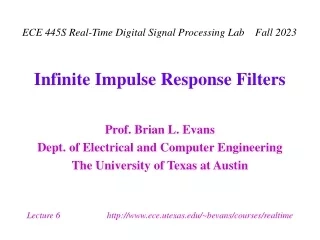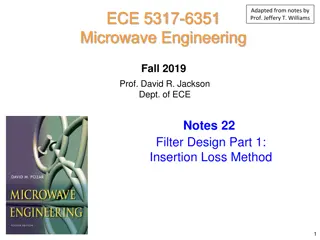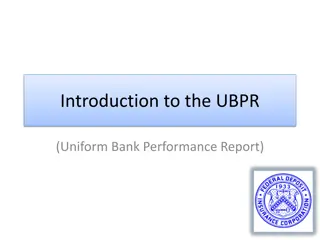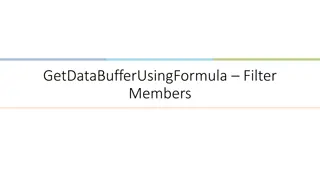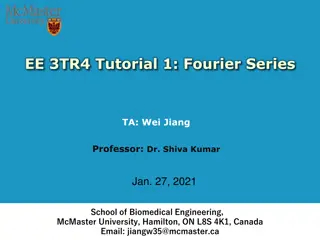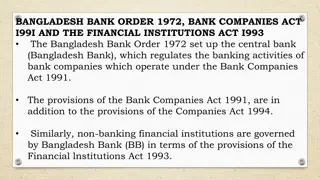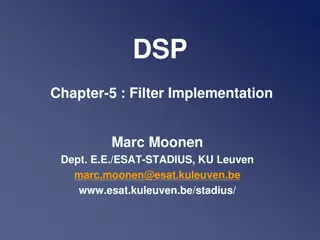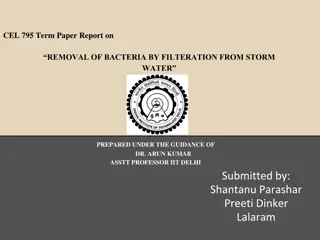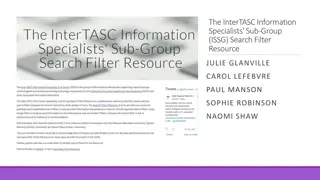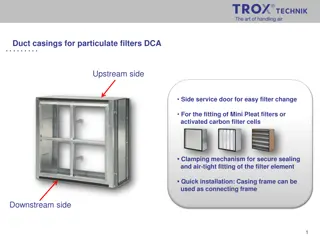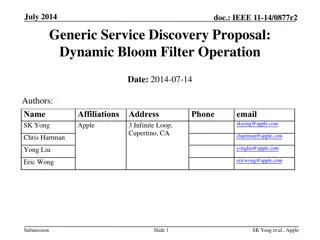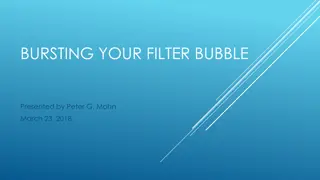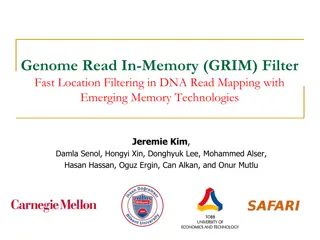
Filter Bank Preliminaries and Set-Up Details
Explore the fundamental concepts of filter banks and subband systems, covering analysis filter banks, decimators, and practical implementations for efficient subband processing. Learn about ideal and non-ideal filter banks, perfect reconstruction theory, and DFT-modulated filter banks in digital signal processing.
Download Presentation

Please find below an Image/Link to download the presentation.
The content on the website is provided AS IS for your information and personal use only. It may not be sold, licensed, or shared on other websites without obtaining consent from the author. If you encounter any issues during the download, it is possible that the publisher has removed the file from their server.
You are allowed to download the files provided on this website for personal or commercial use, subject to the condition that they are used lawfully. All files are the property of their respective owners.
The content on the website is provided AS IS for your information and personal use only. It may not be sold, licensed, or shared on other websites without obtaining consent from the author.
E N D
Presentation Transcript
DSP Chapter-8 : Filter Bank Preliminaries Marc Moonen Dept. E.E./ESAT-STADIUS, KU Leuven marc.moonen@esat.kuleuven.be www.esat.kuleuven.be/stadius/
Part-IV : Filter Banks & Subband Systems Filter Bank Preliminaries Filter Bank Set-Up Filter Bank Applications Ideal Filter Bank Operation Non-Ideal Filter Banks: Perfect Reconstruction Theory Chapter-8 Chapter-9 Filter Bank Design Non-Ideal Filter Banks: Perfect Reconstruction Theory (continued) Filter Bank Design Problem Statement General Perfect Reconstruction Filter Bank Design DFT-Modulated Filter Banks DSP 2016 / Chapter 8: Filter Bank Preliminaries 2 / 32
Filter Bank Set-Up What we have in mind is this : subband processing H0(z) OUT IN subband processing H1(z) + subband processing H2(z) subband filters subband processing H3(z) Example with number of channels = N =4 In practice N can be 1024 or more... H0 H1 H2 H3 2 - Signals split into frequency channels/subbands - Per-channel/subband processing - Reconstruction : synthesis of processed signal - Applications : see below (audio coding etc.) - In practice, this is implemented as a multi-rate structure for higher efficiency (see next slides) DSP 2016 / Chapter 8: Filter Bank Preliminaries 3 / 32
Filter Bank Set-Up Step-1: Analysis filter bank - Collection of N filters (`analysis filters , `decimation filters ) with a common input signal - Ideal (but non-practical) frequency responses = ideal bandpass filters - Typical frequency responses (overlapping, non-overlapping, ) 2 H1 H2 H3 H0 N=4 H0(z) 2 H0 H1 H2 H3 IN H1(z) 2 H2(z) H0 H1 H2 H3 H3(z) DSP 2016 / Chapter 8: Filter Bank Preliminaries 4 / 32
Filter Bank Set-Up Step-2: Decimators (downsamplers) - To increase efficiency, subband sampling rate is reduced by factor D (= Nyquist sampling theorem (for passband signals) ) - Maximally decimated filter banks (=critically downsampled): # subband samples = # fullband samples this sounds like maximum efficiency, but aliasing (see below)! - Oversampled filter banks (=non-critically downsampled): # subband samples > # fullband samples D=N D<N N=4 D=3 3 3 3 3 H0(z) IN H1(z) PS: analysis filters Hn(z) are now also decimation/anti-aliasing filters to avoid aliasing in subband signals after decimation (see Chapter-2) H2(z) H3(z) DSP 2016 / Chapter 8: Filter Bank Preliminaries 5 / 32
Filter Bank Set-Up Step-3: Subband processing - Example : coding (=compression) + (transmission or storage) + decoding - Filter bank design mostly assumes subband processing has `unit transfer function (output signals=input signals), i.e. mostly ignores presence of subband processing N=4 D=3 3 3 3 3 subband processing H0(z) IN subband processing H1(z) subband processing H2(z) subband processing H3(z) DSP 2016 / Chapter 8: Filter Bank Preliminaries 6 / 32
Filter Bank Set-Up Step-4&5: Expanders (upsamplers) & synthesis filter bank - Restore original fullband sampling rate by D-fold upsampling - Upsampling has to be followed by interpolation filtering (to fill the zeroes & remove spectral images, see Chapter-2) - Collection of N filters (`synthesis , `interpolation ) with summed output - Frequency responses : preferably `matched to frequency responses of the analysis filters (see below) G0 G1 G2 G3 2 N=4 D=3 3 3 3 3 3 3 3 3 G0(z) subband processing H0(z) OUT IN G1(z) subband processing H1(z) + G2(z) subband processing H2(z) G3(z) subband processing H3(z) DSP 2016 / Chapter 8: Filter Bank Preliminaries 7 / 32
Filter Bank Set-Up So this is the picture to keep in mind... analysis bank (analysis & anti-aliasing) downsampling/decimation upsampling/expansion synthesis bank (synthesis & interpolation) N=4 D=3 3 3 3 3 3 3 3 3 G0(z) subband processing H0(z) OUT IN G1(z) subband processing H1(z) + G2(z) subband processing H2(z) G3(z) subband processing H3(z) DSP 2016 / Chapter 8: Filter Bank Preliminaries 8 / 32
Filter Bank Set-Up A crucial concept concept will be Perfect Reconstruction (PR) Assume subband processing does not modify subband signals (e.g. lossless coding/decoding) The overall aim would then be to have PR, i.e. that the output signal is equal to the input signal up to at most a delay: y[k]=u[k-d] But: downsampling introduces aliasing, so achieving PR will be non- trivial N=4 D=3 y[k]=u[k-d]? 3 3 3 3 3 3 3 3 G0(z) output = input H0(z) u[k] G1(z) output = input H1(z) + G2(z) output = input H2(z) G3(z) output = input H3(z) DSP 2016 / Chapter 8: Filter Bank Preliminaries 9 / 32
Filter Bank Applications Subband coding : Coding = Fullband signal split into subbands & downsampled (=analysis filters + decimators) subband signals separately encoded (e.g. subband with smaller energy content encoded with fewer bits) Decoding = reconstruction of subband signals, then fullband signal synthesis (=expanders + synthesis filters) Example : Image coding (e.g. wavelet filter banks) Example : Audio coding e.g. digital compact cassette (DCC), MiniDisc, MPEG, ... Filter bandwidths and bit allocations chosen to further exploit perceptual properties of human hearing (perceptual coding, masking, etc.) DSP 2016 / Chapter 8: Filter Bank Preliminaries 10 / 32
Filter Bank Applications Subband adaptive filtering : - Example : Acoustic echo cancellation Adaptive filter models (time-varying) acoustic echo path and produces a copy of the echo, which is then subtracted from microphone signal. = Difficult problem ! long acoustic impulse responses time-varying DSP 2016 / Chapter 8: Filter Bank Preliminaries 11 / 32
Filter Bank Applications - Subband filtering = N (simpler) subband modeling problems instead of one (more complicated) fullband modeling problem - Perfect Reconstruction (PR) guarantees distortion-free desired near-end speech signal N=4 D=3 3 3 3 3 3 3 3 3 H0(z) ad.filter ad.filter H1(z) H2(z) H3(z) ad.filter ad.filter 3 3 3 3 + G0(z) G1(z) G2(z) G3(z) H0(z) H1(z) H2(z) OUT + + + + H3(z) DSP 2016 / Chapter 8: Filter Bank Preliminaries 12 / 32
Ideal Filter Bank Operation D= N =4 (*) With ideal analysis/synthesis filters, filter bank operates as follows (1) H0(z) H1(z) H2(z) H3(z) analysis filters 2 IN input signal spectrum p p 4 2 subband processing G0(z) 4 4 H0(z) OUT subband processing G1(z) IN 4 4 H1(z) + subband processing G2(z) 4 4 H2(z) subband processing G3(z) 4 4 H3(z) DSP 2016 / Chapter 8: Filter Bank Preliminaries (*) Similar figures for other D,N & oversampled (D<N) case 13 / 32
Ideal Filter Bank Operation With ideal analysis/synthesis filters, filter bank operates as follows (2) H0(z) H1(z) H2(z) H3(z) 2 x1 PS: H0(z) analysis filter lowpass anti-aliasing filter p x1 p 4 2 subband processing G0(z) 4 4 H0(z) OUT subband processing G1(z) IN 4 4 H1(z) + subband processing G2(z) 4 4 H2(z) subband processing G3(z) 4 4 H3(z) DSP 2016 / Chapter 8: Filter Bank Preliminaries 14 / 32
Ideal Filter Bank Operation With ideal analysis/synthesis filters, filter bank operates as follows (3) x 1 (ideal subband processing) p p 4 2 x 1 x 1 subband processing G0(z) 4 4 H0(z) OUT subband processing G1(z) IN 4 4 H1(z) + subband processing G2(z) 4 4 H2(z) subband processing G3(z) 4 4 H3(z) DSP 2016 / Chapter 8: Filter Bank Preliminaries 15 / 32
Ideal Filter Bank Operation With ideal analysis/synthesis filters, filter bank operates as follows (4) x 1 p p 4 2 x 1 subband processing G0(z) 4 4 H0(z) OUT subband processing G1(z) IN 4 4 H1(z) + subband processing G2(z) 4 4 H2(z) subband processing G3(z) 4 4 H3(z) DSP 2016 / Chapter 8: Filter Bank Preliminaries 16 / 32
Ideal Filter Bank Operation With ideal analysis/synthesis filters, filter bank operates as follows (5) G0(z) G1(z) G2(z) G3(z) PS: G0(z) synthesis filter lowpass interpolation filter 2 x 1 p p 4 2 x 1 subband processing G0(z) 4 4 H0(z) OUT subband processing G1(z) IN 4 4 H1(z) + subband processing G2(z) 4 4 H2(z) subband processing G3(z) 4 4 H3(z) DSP 2016 / Chapter 8: Filter Bank Preliminaries 17 / 32
Ideal Filter Bank Operation With ideal analysis/synthesis filters, FB operates as follows (6) H0(z) H1(z) H2(z) H3(z) 2 x2 PS: H1(z) analysis filter bandpass anti-aliasing filter p p 4 2 subband processing G0(z) 4 4 H0(z) x2 OUT subband processing G1(z) IN 4 4 H1(z) + subband processing G2(z) 4 4 H2(z) subband processing G3(z) 4 4 H3(z) DSP 2016 / Chapter 8: Filter Bank Preliminaries 18 / 32
Ideal Filter Bank Operation With ideal analysis/synthesis filters, filter bank operates as follows (7) x 2 p p 4 2 3p subband processing G0(z) 4 4 H0(z) x 2 x 2 OUT subband processing G1(z) IN 4 4 H1(z) + subband processing G2(z) 4 4 H2(z) subband processing G3(z) 4 4 H3(z) DSP 2016 / Chapter 8: Filter Bank Preliminaries 19 / 32
Ideal Filter Bank Operation With ideal analysis/synthesis filters, filter bank operates as follows (8) IN x 2 p p 4 2 subband processing G0(z) 4 4 H0(z) x 2 OUT subband processing G1(z) IN 4 4 H1(z) + subband processing G2(z) 4 4 H2(z) subband processing G3(z) 4 4 H3(z) DSP 2016 / Chapter 8: Filter Bank Preliminaries 20 / 32
Ideal Filter Bank Operation With ideal analysis/synthesis filters, filter bank operates as follows (9) G0(z) G1(z) G2(z) G3(z) 2 x 2 PS: G1(z) synthesis filter bandpass interpolation filter p p 4 2 subband processing G0(z) 4 4 H0(z) x 2 OUT subband processing G1(z) IN 4 4 H1(z) + subband processing G2(z) 4 4 H2(z) subband processing G3(z) 4 4 H3(z) DSP 2016 / Chapter 8: Filter Bank Preliminaries 21 / 32
Ideal Filter Bank Operation With ideal analysis/synthesis filters, filter bank operates as follows (10) OUT=IN =Perfect Reconstruction p p 4 2 subband processing G0(z) 4 4 H0(z) OUT subband processing G1(z) IN 4 4 H1(z) + subband processing G2(z) 4 4 H2(z) subband processing G3(z) 4 4 H3(z) DSP 2016 / Chapter 8: Filter Bank Preliminaries Now try this with non-ideal filters ? 22 / 32
Non-Ideal Filter Bank Operation Question : Can y[k]=u[k-d] be achieved with non-ideal filters i.e. in the presence of aliasing ? Answer : YES !! Perfect Reconstruction Filter Banks (PR-FB) with synthesis bank designed to remove aliasing effects ! D=3 N=4 y[k]=u[k-d]? 3 3 3 3 3 3 3 3 G0(z) output = input H0(z) u[k] G1(z) output = input H1(z) + G2(z) output = input H2(z) G3(z) output = input H3(z) DSP 2016 / Chapter 8: Filter Bank Preliminaries 23 / 32
Non-Ideal Filter Bank Operation D= N =4 (*) A very simple PR-FB is constructed as follows - Starting point is this 0,0,0,u[0],0,0,0,u[4],0,0,0,... 0,0,u[-1],0,0,0,u[3],0,0,0,0,... 4 4 4 4 4 1 3 z 4 4 4 1 2 z z z z u[k-3] u[k] + 2 1 z 1 3 0,u[-2],0,0,0,u[2],0,0,0,0,0,... u[-3],0,0,0,u[1],0,0,0,0,0,0,... As y[k]=u[k-d] this can be viewed as a (1st) (maximally decimated)PR-FB (with lots of aliasing in the subbands!) All analysis/synthesis filters are seen to be pure delays, hence are not frequency selective (i.e. far from ideal case with ideal bandpass filters, not yet very interesting .) DSP 2016 / Chapter 8: Filter Bank Preliminaries (*) Similar figures for other D=N 24 / 32
Non-Ideal Filter Bank Operation - Now insert DFT-matrix (discrete Fourier transform) and its inverse (I-DFT)... 4 4 4 4 4 1 3 z u[k] 4 4 4 F 1 2 z z z z u[k-3] 1 F + 2 1 z 1 3 v FF-1v F.F-1= I as this clearly does not change the input-output relation (hence PR property preserved) DSP 2016 / Chapter 8: Filter Bank Preliminaries 25 / 32
Non-Ideal Filter Bank Operation - and reverse order of decimators/expanders and DFT- matrices (not done in an efficient implementation!) : 4 4 4 4 4 1 3 z u[k] 4 4 4 F 1 2 1 z z z z u[k-3] F + 2 1 z 1 3 =analysis filter bank =synthesis filter bank This is the `DFT/IDFT filter bank It is a first (or 2nd) example of a (maximally decimated) PR-FB! DSP 2016 / Chapter 8: Filter Bank Preliminaries 26 / 32
Non-Ideal Filter Bank Operation What do analysis filters look like? (N-channel case) 3 z H0(z) H1(z) H2(z) : HN-1(z) W0 W0 W0 : W0 W0 W-1 W-2 : W-(N-1) W0 W-2 W-4 : W-2(N-1) W0 1 ... ... ... W-2(N-1) N=4 z-1 z-2 : z-N+1 W-(N-1) 1 =1 . u[k] N 1 1 z z F : 2 ... W-(N-1)2 W =e-j2p/N k This is seen/known to represent a collection of filters Ho(z),H1(z),..., each of which is a frequency shifted version of Ho(z) : Hn(ejw)= H0(ej(w-n.(2p/N))) H0(z)=1 N.(1+z-1+z-2+...+z-N+1) i.e. the Hn are obtained by uniformly shifting the `prototype Ho over the frequency axis. DSP 2016 / Chapter 8: Filter Bank Preliminaries 27 / 32
Non-Ideal Filter Bank Operation H3(z) Ho(z) H2(z) H1(z) The prototype filter Ho(z) is a not-so-great lowpass filter with significant sidelobes. Ho(z) and Hi(z) s are thus far from ideal lowpass/bandpass filters. Synthesis filters are shown to be equal to analysis filters (up to a scaling) N=4 Hence (maximal) decimation introduces significant ALIASING in the decimated subband signals Still, we know this is a PR-FB (see construction previous slides), which means the synthesis filters can apparently restore the aliasing distortion. This is remarkable, it means PR can be achieved even with non-ideal filters! DSP 2016 / Chapter 8: Filter Bank Preliminaries 28 / 32
Perfect Reconstruction Theory Now comes the hard part (?) 2-channel case: Simple (maximally decimated, D=N) example to start with N-channel case: Polyphase decomposition based approach DSP 2016 / Chapter 8: Filter Bank Preliminaries 29 / 32
Perfect Reconstruction : 2-Channel Case D= N =2 y[k] F0(z) u[k] 2 2 H0(z) + F1(z) 2 2 H1(z) It is proved that...(try it!) 1 1 = + + + ( ) .{ ( ). ( ) ( ) ( )} . U ( ) .{ ( ). ( ) ( ) ( )} . U ( ) Y z H z F z H z F z z H z F z H z F z z 0 0 1 1 0 0 1 1 2 2 ( ) ( ) T z A z U(-z) represents aliased signals (*), hence A(z) is referred to as `alias transfer function T(z) referred to as `distortion function (amplitude & phase distortion) Note that T(z) is also the transfer function obtained after removing the up- and downsampling (up to a scaling) (!) ) ( = z A 0 = z ( ) T z Perfect reconstruction if: (*) U(-z)z=ejw=U(-ejw)=U(ejw+p) DSP 2016 / Chapter 8: Filter Bank Preliminaries 30 / 32
Perfect Reconstruction : 2-Channel Case A solution is as follows: (ignore details)[Smith&Barnwell 1984] [Mintzer 1985] i) ) ( ), ( ) ( 1 1 0 z F z H z F = = ( ) H z 0 ) = = ( ... 0 A z so that (alias cancellation) ii) `power symmetric Ho(z) (real coefficients case) 2 2 + ( ) ( ) j j + = ( ) ( ) 1 H e H e 2 2 0 0 = ) 1 k [ ] ( . [ ] h k h L k iii) so that (distortion function) ignore the details! 1 0 = = ( ) ... 1 T z This is a so-called`paraunitary perfect reconstruction bank (see below), based on a lossless system Ho,H1 : 2 2 j j + = ( ) ( ) 1 H e H e 0 1 DSP 2016 / Chapter 8: Filter Bank Preliminaries This is already pretty complicated 31 / 32
Perfect Reconstruction : N-Channel Case D= N D=N=4 F0(z) 4 4 H0(z) u[k] y[k] F1(z) 4 4 H1(z) + F2(z) 4 4 H2(z) F3(z) 4 4 H3(z) It is proved that...(try it!) N-1 N-1 N-1 Y(z)=1 .U(z)+1 Hn(z.Wn).Fn(z)} .U(z.Wn) N.{ Hn(z).Fn(z) } N. { n=0 n=1 n=0 T(z) An(z) 2nd term represents aliased signals, hence for perfect reconstruction, all `alias transfer functions An(z) (n=1..N-1) should be zero T(z) is referred to as `distortion function (amplitude & phase distortion). For perfect reconstruction, T(z) should be a pure delay Sigh !! Too Complicated!!... DSP 2016 / Chapter 8: Filter Bank Preliminaries 32 / 32

